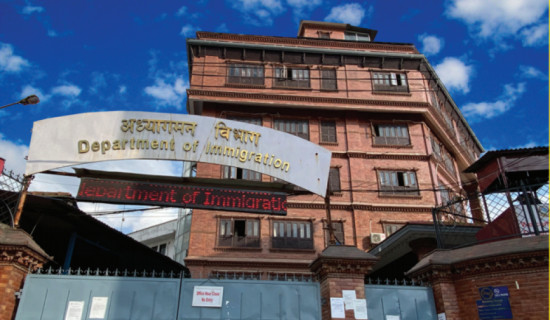- Tuesday, 30 December 2025
Stem Youth Exodus For National Development
Nepal’s youth diaspora is on the rise, driven by waning optimism about the country’s future. What was once a personal decision has become a generational inevitability. In the capital, migration is no longer seen as a choice. It has become a rite of passage. People joke, “If your children are still home after 20, check if they’re okay.” But beneath the humor is quiet resignation. Economic necessity has long propelled Nepalis' migration, historically beginning with trade and advancing through British colonial military recruitment.
The liberalised passport regime in Nepal, Gulf countries’ rising demand for labour, and the start of the Maoist civil war all contributed to increasing migration in the 1990s. India continues to be the primary destination for Nepali migrants, but now around 80 per cent of migrant workers from Nepal are employed in Gulf countries, mostly working jobs that are physically demanding and less cerebral. Some of the newer European countries, as well as Japan and South Korea, have also emerged as key destinations. The willingness to move overseas for economic opportunities, especially under such perilous circumstances, demonstrates the enterprising qualities of Nepali workers.
Economic frailty
This sustained outflow of labour has made remittance the backbone of the economy. In 2024, the government granted more than 700,000 labour permits, which does not include student visa holders and undocumented exits. Currently, 4.3 million Nepalis, which is nearly one out of seven citizens, reside outside the country. This, coupled with the current exodus, signifies an intense dependency on remittance. In 2024, remittance inflows equalled about 25 per cent of the GDP. This positioned Nepal as one of the most remittance-centric economies in the world, just behind Tajikistan and Lebanon. Though remittances fuel the economy, they also conceal deep-rooted economic frailty.
The problem isn’t difficult to trace. Political instability has forced the youth to seek greener pastures. In the past two decades, 14 different governments have taken charge without any endgame. All of them have claimed to initiate reforms, but their efforts have remained underwhelming. Public trust has plunged due to policy change volatility, bureaucratic ineptitude, corruption, and waning reliability. On the Corruption Perception Index, Nepal still ranks as one of the most corrupt countries in South Asia.
This paralysis hampers economic dynamism. Agriculture still employs over 60 per cent of the workforce but makes up only 24 per cent of the GDP. The manufacturing industry is not doing any better. There is also the service sector, which is growing; however, most of it is insular. With pedestrian growth, the standard of living is far from impressive. In Kathmandu, housing prices have increased by more than 35 per cent in the last 5 years. Food, transport, and other daily needs have also become more expensive with inflation averaging 8.2 per cent for early 2025. A recent university graduate making NPR 20,000 to 25,000 (USD 150 to 190) is earning barely enough to cover basic expenses. In contrast, low-skilled jobs in Gulf nations, Malaysia, or South Korea pay two to three times this amount, and often cover accommodation. The opportunity cost of staying has become simply too high.
Migration, when controlled, has shown positive economic outcomes. South Korea during the 1960s and Ireland in the 1990s welcomed labour migration not as an exit strategy, but as a phase accompanied by a well-thought-out economic plan. Returnees were welcomed back and reintegrated through planning, vocational programmes, and rejuvenation of industries. Its investment of 3.5 per cent of GDP in vocational and technical education has remarkably reduced youth unemployment and bolstered talent retention.
Contrastingly, Nepal lacks these frameworks. There is no mosaic plan for reintegration, no assimilation strategy for absorbing returnee workers, and little incentive for can-do professionals to relocate back. Furthermore, Dhanusha, Achham, and Gulmi districts showcase entire populations with a handful of working-aged men. The societal effects are devastating. Young women burdened with caregiving duties, children growing up with absent fathers, and increasing mental health issues among divided families. From an economic standpoint, Nepal is losing its most productive generation. Even after years working abroad, 41 per cent of returnee migrants are still unemployed or underemployed and often unable to find work that matches their skill level.
Historical inflection
Nepal now stands at a historical inflection. With 63 per cent of its population under the age of 30, the country still possesses immense latent potential. Even those who remain are not idle by choice. Many youths, influenced by political parties, still crowd the streets in orchestrated demonstrations. These protests are not expressions of ideological commitment but the product of directionless existence. With few jobs, no training, and even fewer alternatives, agitation becomes the only visible form of engagement. It is a tragic misuse of human capital and a symptom of a society in retreat.
What is direly needed is not another development blueprint, but a single plan for the entire nation that integrates education, proper job pathways, and entrepreneurial ventures. Investment in vocational education, digitisation of farming, extension of digital networks, and setting up of micro-enterprises will go a long way in changing things for the better. To help change things for the better, there is a need for capital incentivisation through diaspora bonds, tax savings for returnees, and innovation hubs.
But none of this will make any difference unless one primary aspect is considered: trust. Young people particularly need to believe their future is something to be cultivated where they are, not through departure. If that belief is not restored, then Nepal’s greatest resource, its people, will keep disappearing, one boarding pass at a time.
(The author is a Data Analyst at Fujitsu, Portugal)




-square-thumb.jpg)
-square-thumb.jpg)









-original-thumb.jpg)

